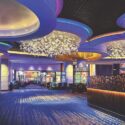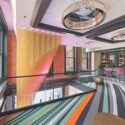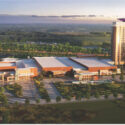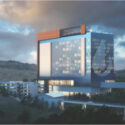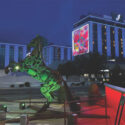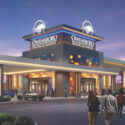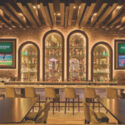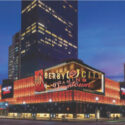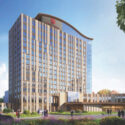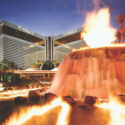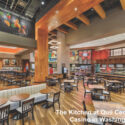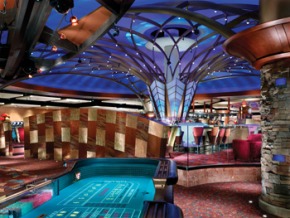
Casino design has always been all about aesthetics. In the old days, the aesthetics were simple: Dark reds, no natural light, nothing to distract customers from the games. Eventually, design evolved into creating various spaces where people can escape everyday life, whether gambling or not.
Of course, parallel to the evolution of casino design has been the evolution of technology—technology in the games themselves, and in the displays surrounding the games within the casino.
Technology has certainly given designers and architects unprecedented abilities to show clients their concepts, as computer modeling has replaced sketches and allowed designers to present virtual tours of the space they intend to create. “Everything is explored through 3D computer models now,” comments Rick Gardner, senior partner of architecture firm Hnedak Bobo Group. “It allows you to quickly organize plans, and provides a great communication tool between designers and operators.”
“The advent of computer-based design has transformed our industry,” adds Michael Prifti, managing principal of BLT Architects. “We can offer photo-realistic renderings, and real-time movement through a space. Through a web interface, we have the ability to let you, using your mouse pad, turn around, walk up stairs, go in an elevator—choose where you want to go.”
These virtual trips through spaces that do not yet physically exist provide perhaps the best advancement in designer/client communication during conceptual stages, but what about the concepts themselves? How has technology changed the way a casino floor is designed?
Not much in its most basic form. Gardner says that other than the casino cage placement—it is much less important since the advent of ticketing slots and self-payment kiosks—technology has not changed the overall layout. “In overall design and macro space planning, I don’t think design has fundamentally changed,” he says. “The relationship between slots and tables is the same—we want clear way-finding, we emphasize the perimeter, we have good relationships between food and gaming areas, and parking. On a broad level, it hasn’t change a lot.”
What has changed, though, is the environment that can be created within that broad space. Some of these changes can be attributed simply to advancements in the materials used to create the fine details of a casino property. For example, new, lighter materials can combine with energy-efficient lighting in some areas of a casino resort to enable use of top-quality elements in other areas, even without a top-luxury budget. “We’re constantly looking at and testing new materials that achieve the visual effect or technical requirements we need, that can also be built faster and/or for less money,” says Prifti. “The savings let you use materials elsewhere in the property that are richer.
“We can save money if the overall building is lighter. Exterior panels of carbon-reinforced cement can be used instead of steel. The panels can be extremely thin; they can be delivered by truck and installed quickly. That saving can be put into higher-end elements in the quality of the floor, the millwork, or the character of the lighting—things that customers will notice.”
Advanced technology outside the realm of architecture also can give designers more freedom in planning the casino room. Tom Hoskens, a principal in the architectural firm Cuningham Group, says video surveillance technology is a prime example. “I love the new surveillance cameras,” he says. “Because of advances in camera technology, we can now create higher ceilings, and we can create lighting effects that never were possible before. We can now put a ceiling up 40 feet, and the cameras are still able to read the cards. It gives us a freedom; it puts more tools in our toolbox.”
Lively Spaces
While the basic design of a casino floor has remained constant over the years, designers have had to adapt to the changing technology of what the operators will ultimately place in that space. Elements like video and computerized lighting must now be considered during the design phase.
“We still have basic axioms on how you lay out a gaming floor, but what technology has enabled us to do is to activate niche areas that before were somewhat dead,” says Hoskens. “It goes to the types of lighting we’re using—LED, inside and outside, with computer controls, and video monitors. Now, if someone wins a jackpot, I can let it be known throughout the casino. The excitement and feeding frenzy you formerly created around 20 machines can now be created throughout your casino.”
Formerly dead space can now be occupied by ever-changing displays of video, lights and other display features, Hoskens says, adding that video can be used to cross-sell various attractions in the casino.
Gardner agrees. “The biggest thing we’ve seen along the lines of the aesthetic elements of a casino floor is that video is very prevalent, not just in the sports bar but everywhere,” he says. “That video becomes a good tool for the operator in advertising events and promotions.”
Gardner notes that in the past, it would have been unthinkable to include such distractions as video of sporting events or promotions on a casino floor. “But we’ve become accustomed to a steady flow of stimulus—multi-tasking. Even those of us over 50 are accustomed to such technology, so it’s not a distraction anymore.”
The multitude of stimuli extends to the games themselves, which typically have their own video and light shows going. “The graphics on the slot products have become phenomenal,” says Hoskens. “We’ve got electronic ladies dealing blackjack in a bikini, and they look pretty darned good! Operators are able to place these around the casino to activate areas. I was in Australia, and noticed how horse-racing and keno games are used to take a dead corner and activate it with a huge screen. It’s gone a long way to revolutionizing how a floor can be designed.”
“With all the new video and lighting technology, the gaming floor has become very dynamic and kinetic,” says Gardner. “The operator can change the mood of the environment, and with video and lighting, all this activity has become an important part of the aesthetic. Because of that, the style of casinos is becoming more contemporary.”
The other effect of the changing technology in lighting, video and the displays surrounding the games themselves is that designers must plan for the dynamic nature of the visuals that will end up on the floor. In other words, slot floor designs must be flexible.
“For the casino operator, technology has become far more sophisticated,” notes Joel Bergman, chairman of architectural firm Bergman, Walls & Associates, Ltd. “The operator is able to track the play of customers more precisely. Feedback is instantaneous, so the operators are able to adjust the gaming floor. My job is to make sure they have the flexibility to do that.”
“We’re building more flexibility into the design of the floor,” says Prifti of BLT Architects. “Raised floor decks, cabling from copper to fiber. Table games remain in a fixed place, but slots will move continually up until the day you open. The floor layout must handle that ability to change the floor.”
The design challenges only stand to increase as the nature of games on the slot floor changes. Server-based gaming, community-style games and the arrival of the Xbox generation on the casino floor will inevitably lead to more changes in floor layout.
“The games will evolve,” says Hoskens. “Just look at what’s out there today. Who would ever have guessed that Star Trek would be a game? There is a lot more coming out. You’ll end up playing war games with your buddy at the next machine.”
“The games themselves are going to change to suit human tastes, to a degree not yet known,” says Prifti. “What will be the allure? If someone’s playing this game, what will the significant other be doing? What completely different thing is there that someone’s going to want to do? Xbox and PC games? What about online fantasy sports leagues? Some states allow sports betting—will fantasy sports betting come? The gaming floor will have to adapt to these changes.”
Energy and Comfort
In the end, what technology has not changed about casino design is that the end product must provide a good mix of collective energy and individual player comfort.
The collective energy certainly has been helped along by the new games, but Gardner says spacing of the games in the layout also has become a fine art. “There’s an interesting balance on the casino floor,” he says. “You want it to feel full—a crowded place creates its own energy. At the same time, personal space has increased. It’s a fine balance between energy and comfort.
“Twenty years ago, casino layouts were disorganized on purpose. Fundamentally, most designers now make sure there’s clear organization and path finding. You create landmarks with center bars and other architectural features so people don’t get lost.”
For Bergman, advanced technology is fine, as long as it doesn’t get in the way of that player comfort. “Some of our facilities take advantage of LED lighting and rapid-changing colors, but we’re very careful not to do it to distraction,” he says. “Design is still about people, and the relationship of people to the equipment. It’s not only about how we arrange and organize the gaming floor itself but all of the peripherals and margins around the gaming floor.”
Bergman also stresses the fact that technology has given designers additional tools doesn’t mean those tools always need to be used. The ability to make ceilings higher, for instance, is a matter of what the designer’s goal is for a particular space.
“Height is more about the mood we want to create,” says Bergman. “In some, a higher ceiling is desirable for aesthetic reasons, and in others, we keep it lower to create a comfy-cozy atmosphere for the players. The fact we can spot the number of hairs on an eyebrow with the cameras is not as important as making the player more comfortable.”
In the end, all the designers agree that advanced technology has simply afforded the tools to create designs more efficiently—the designs themselves still boil down to creating a space where customers want to be. In this respect, Bergman cautions casinos to use technology to augment the human touch, rather than to replace it.
“If we want the customer to feel comfortable in a space, it has less to do with technology than color and texture—combined with how the operator makes the player feel,” Bergman says. “Technology is wonderful, but if it eliminates the personal contact an operator has with his customers, it won’t matter—because you’ll have an empty casino.”



